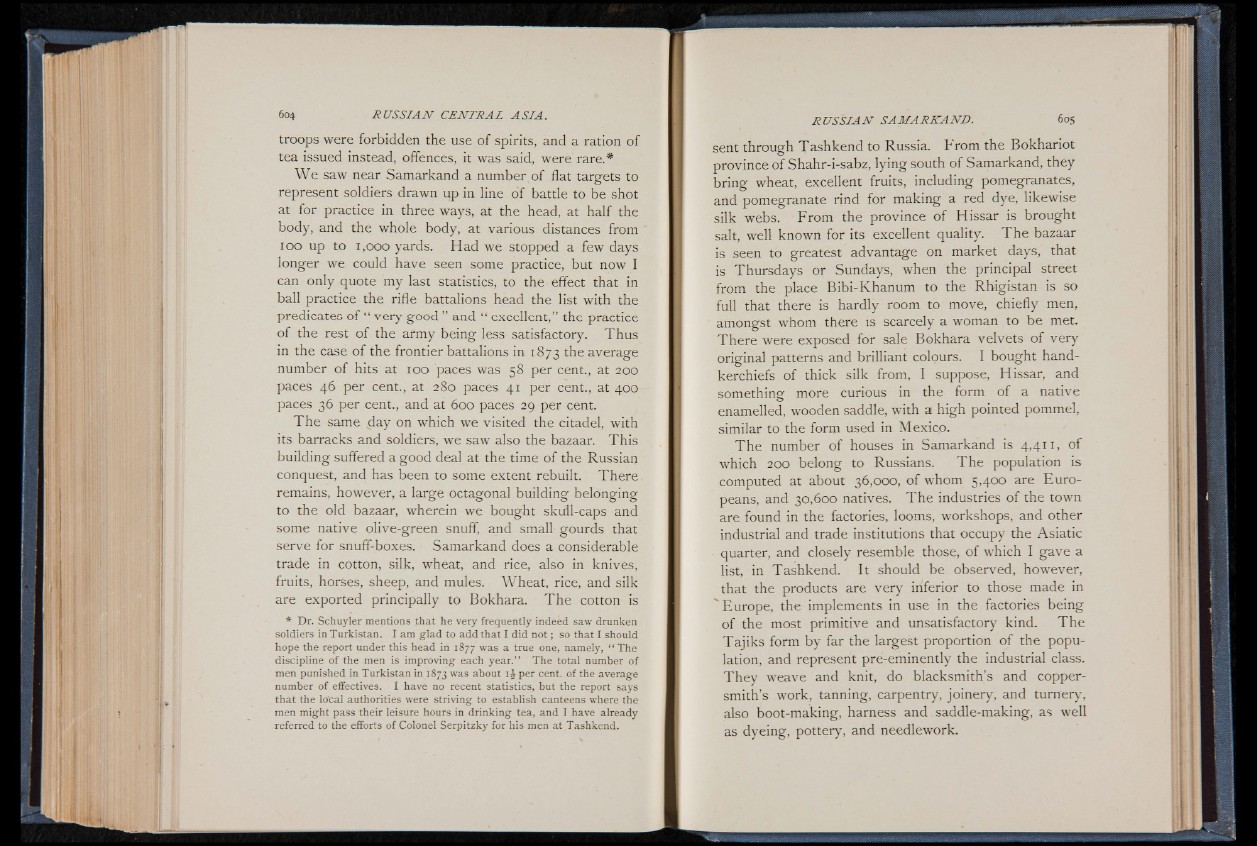
troops were forbidden the use of spirits, and a ration of
tea issued instead, offences, it was said, were rare.*
We saw near Samarkand a number of flat targets to
represent soldiers drawn up in line of battle to be shot
at for practice in three ways, at the head, at half the
body, and the whole body, at various distances from
too up to 1,000 yards. Had we stopped a few days
longer we could have seen some practice, but now I
can only quote my last statistics, to the effect that in
ball practice the rifle battalions head the list with the
predicates of “ very good ” and “ excellent,” the practice
of the rest of the army being less satisfactory. Thus
in the case of the frontier battalions in 1873 the average
number of hits at 100 paces was 58 per cent., at 200
paces 46 per cent., at 280 paces 41 per cent., at 400
paces 36 per cent., and at 600 paces 29 per cent.
The same day on which we visited the citadel, with
its barracks and soldiers, we saw also the bazaar. This
building suffered a good deal at the time of the Russian
conquest, and has been to some extent rebuilt. There
remains, however, a large octagonal building belonging
to the old bazaar, wherein we bought skull-caps and
some native olive-green snuff, and small gourds that
serve for snuff-boxes. Samarkand does a considerable
trade in cotton, silk, wheat, and rice, also in knives,
fruits, horses, sheep, and mules. Wheat, rice, and silk
are exported principally to Bokhara. The cotton is
* Dr. Schuyler mentions that he very frequently indeed saw drunken
soldiers in Turkistan. I am g lad to add that I did n o t ; so that I should
hope the report under this head in 1877 was a true one, namely, “ The
discipline of the men is improving each year.” The total number of
men punished in Turkistan in 1873 was about i j per cent, of the average
number of effectives. I have no recent statistics, but the report says
that the lo'cal authorities were striving to establish canteens where the
men might pass their leisure hours in drinking tea, and I have already
referred to the efforts of Colonel Serpitzky for his men at Tashkend.
sent through Tashkend to Russia. From the Bokhariot
province o f Shahr-i-sabz, lying south of Samarkand, they
bring wheat, excellent fruits, including pomegranates,
and pomegranate rind for making a red dye, likewise
silk webs. From the province of Hissar is brought
salt, well known for its excellent quality. The bazaar
is seen to greatest advantage on market days, that
is Thursdays or Sundays, when the principal street
from the place Bibi-Khanum to the Rhigistan is so
full that there is hardly room to move, chiefly men,
amongst whom there is scarcely a woman to be met.
There were exposed for sale Bokhara velvets of very
original patterns and brilliant colours. I bought handkerchiefs
of thick silk from, I suppose, Hissar, and
something more curious in the form of a native
enamelled, wooden saddle, with a high pointed pommel,
similar to the form used in Mexico.
The number of houses in Samarkand is 4,411, of
which 200 belong to Russians. The population is
computed at about 36,000, of whom 5,400 are Europeans,
and 30,600 natives. The industries of the town
are found in the factories, looms, workshops, and other
industrial and trade institutions that occupy the Asiatic
quarter, and closely resemble those, of which I gave a
list, in Tashkend. It should be observed, however,
that the products are very inferior to those made in
v Europe, the implements in use in the factories being
of the most primitive and unsatisfactory kind. The
Tajiks form by far the largest proportion of the population,
and represent pre-eminently the industrial class.
They weave and knit, do blacksmith’s and coppersmith’s
work, tanning, carpentry, joinery, and turnery,
also boot-making, harness and saddle-making, as well
as dyeing, pottery, and needlework.